Gene Expression In Breast Cancer
VerifiedAdded on 2022/08/08
|10
|2969
|32
AI Summary
The Topic is Breast Cancer Gene expression using existing available data. These questions needs to be well explained: -The Gene Expression and its Role in breast cancer. -What is the point of gene expression analysis and why we use it in cancer? -In the report i need to know specifically about the Gene expression itself and what is in the gene expression data? -What are the Methods and how do scientists find out which gene expression causes the cancer based on their gene expression analysis and data. I am not really interested in cancer however, i really need specific information about gene expression and its role in breast cancer, please pay attention to the questions that were listed above. In reference i will need few articles about gene expression from scientific journals and textbooks.
Contribute Materials
Your contribution can guide someone’s learning journey. Share your
documents today.
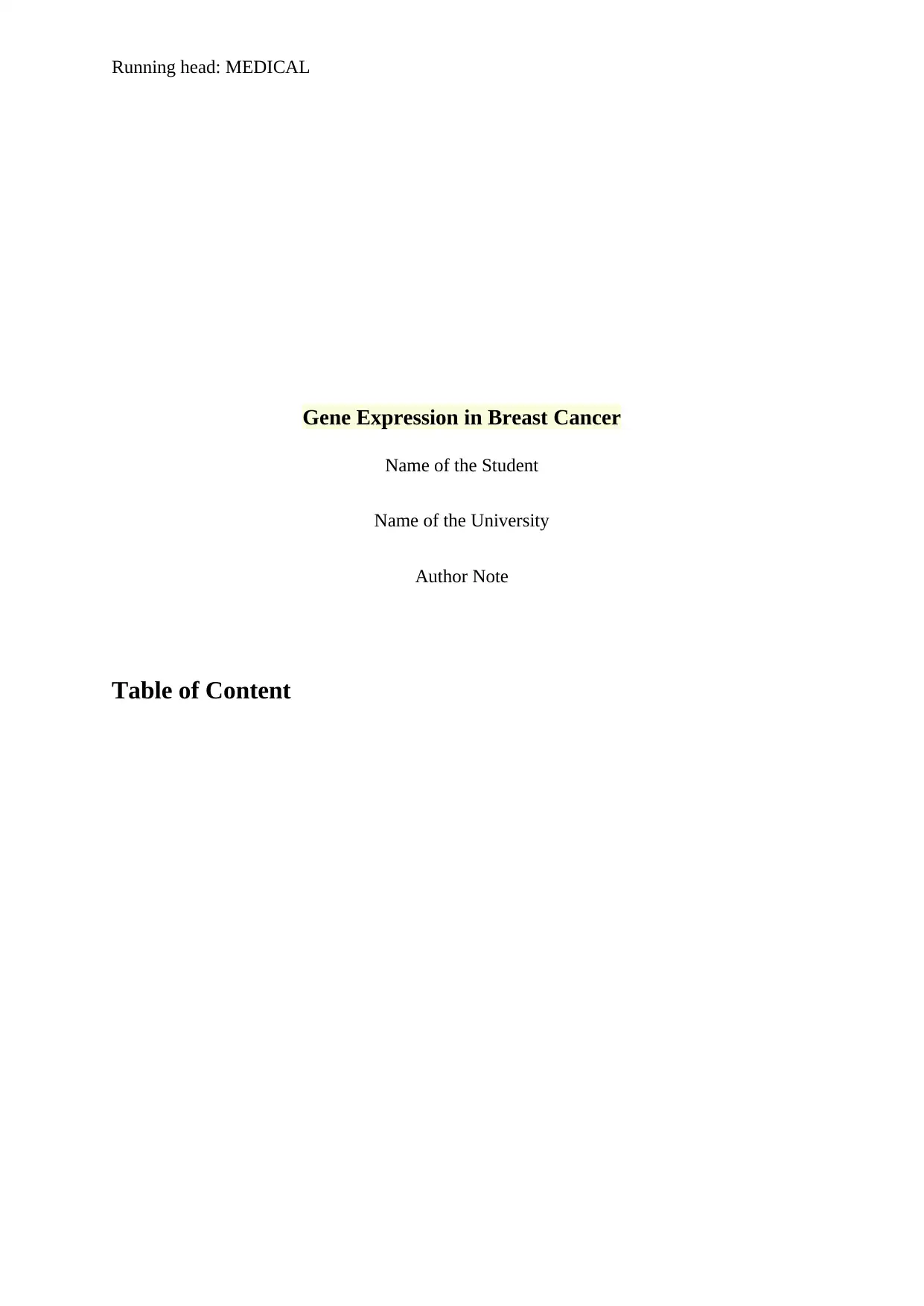
Running head: MEDICAL
Gene Expression in Breast Cancer
Name of the Student
Name of the University
Author Note
Table of Content
Gene Expression in Breast Cancer
Name of the Student
Name of the University
Author Note
Table of Content
Secure Best Marks with AI Grader
Need help grading? Try our AI Grader for instant feedback on your assignments.
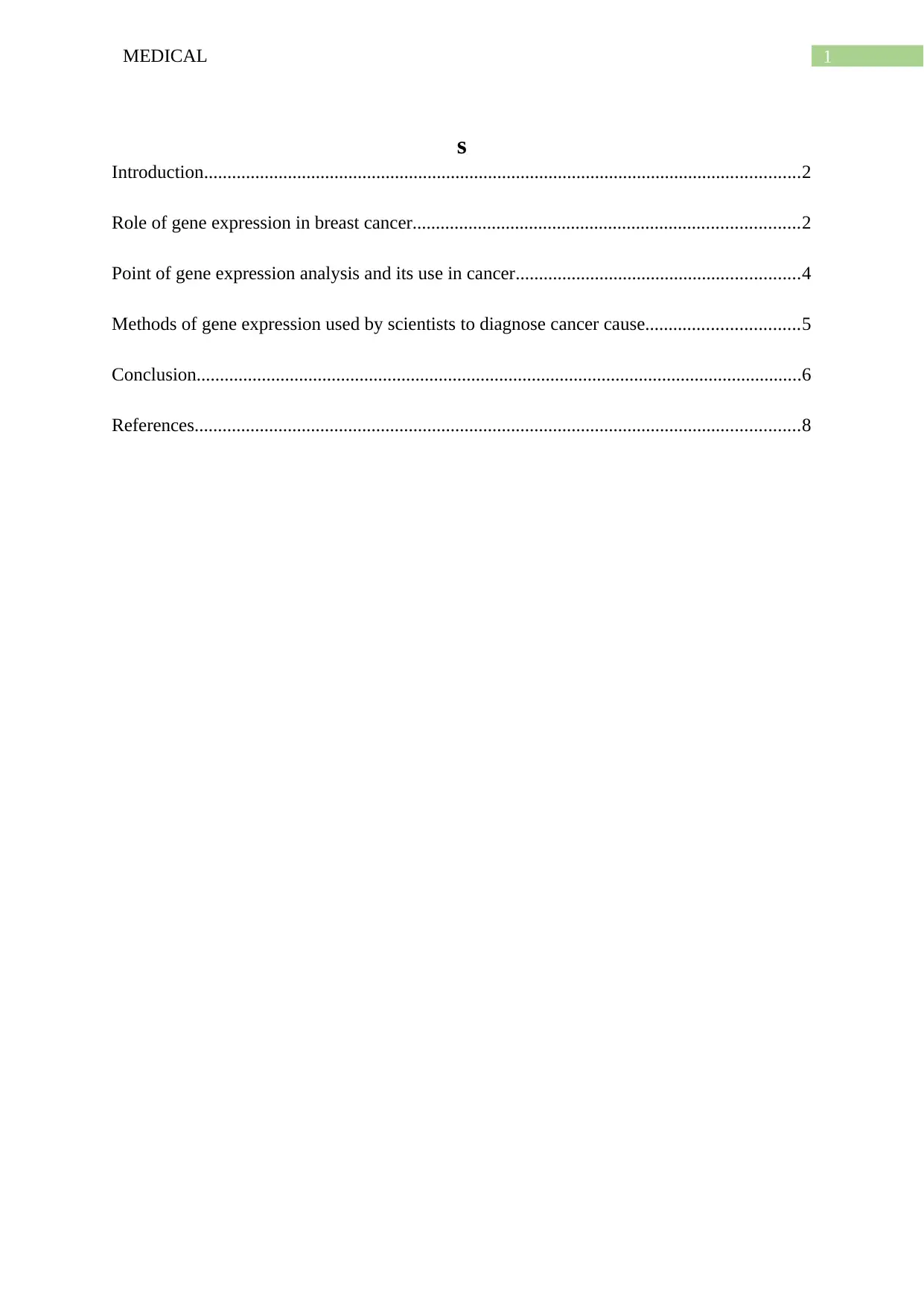
1MEDICAL
s
Introduction................................................................................................................................2
Role of gene expression in breast cancer...................................................................................2
Point of gene expression analysis and its use in cancer.............................................................4
Methods of gene expression used by scientists to diagnose cancer cause.................................5
Conclusion..................................................................................................................................6
References..................................................................................................................................8
s
Introduction................................................................................................................................2
Role of gene expression in breast cancer...................................................................................2
Point of gene expression analysis and its use in cancer.............................................................4
Methods of gene expression used by scientists to diagnose cancer cause.................................5
Conclusion..................................................................................................................................6
References..................................................................................................................................8
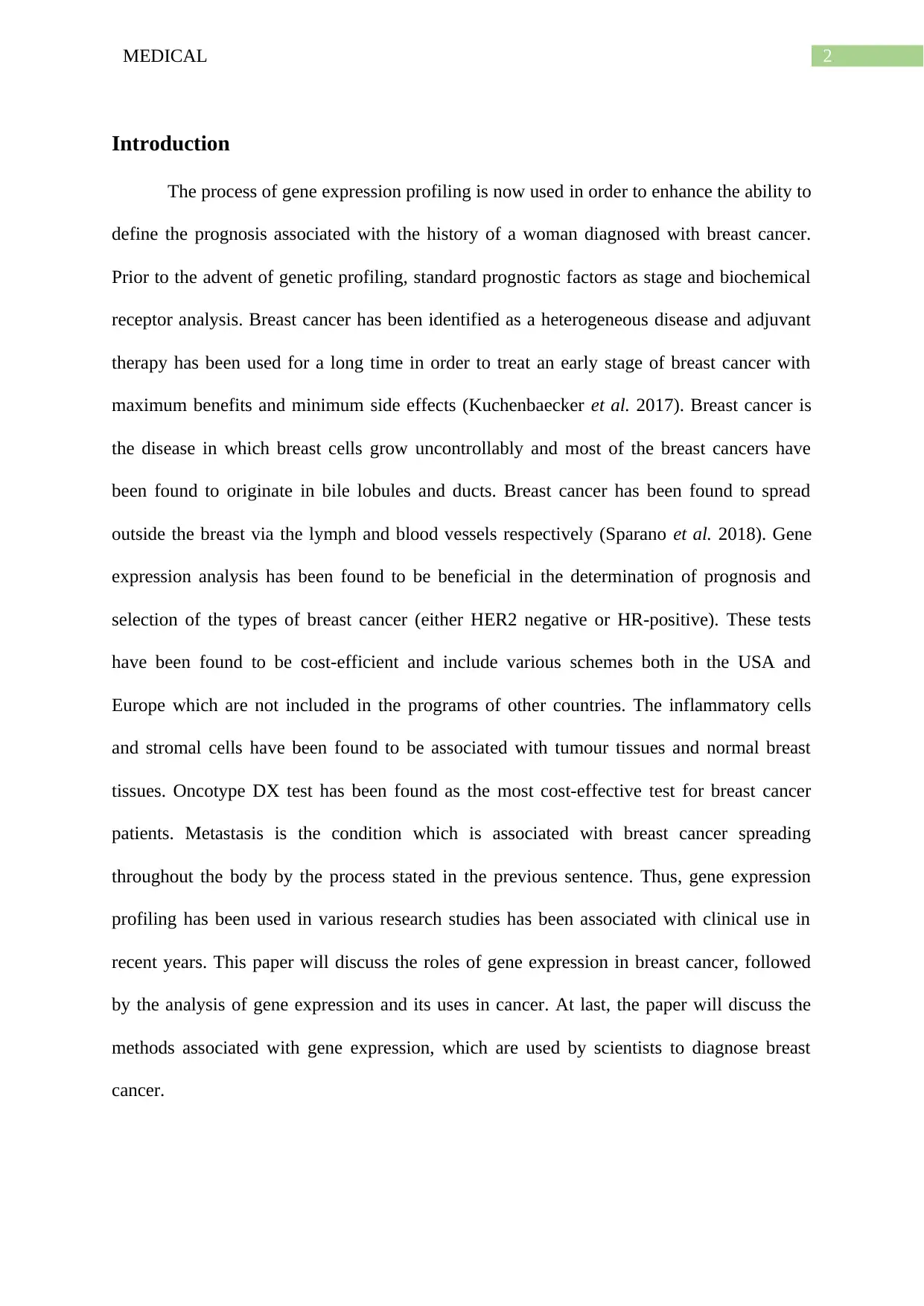
2MEDICAL
Introduction
The process of gene expression profiling is now used in order to enhance the ability to
define the prognosis associated with the history of a woman diagnosed with breast cancer.
Prior to the advent of genetic profiling, standard prognostic factors as stage and biochemical
receptor analysis. Breast cancer has been identified as a heterogeneous disease and adjuvant
therapy has been used for a long time in order to treat an early stage of breast cancer with
maximum benefits and minimum side effects (Kuchenbaecker et al. 2017). Breast cancer is
the disease in which breast cells grow uncontrollably and most of the breast cancers have
been found to originate in bile lobules and ducts. Breast cancer has been found to spread
outside the breast via the lymph and blood vessels respectively (Sparano et al. 2018). Gene
expression analysis has been found to be beneficial in the determination of prognosis and
selection of the types of breast cancer (either HER2 negative or HR-positive). These tests
have been found to be cost-efficient and include various schemes both in the USA and
Europe which are not included in the programs of other countries. The inflammatory cells
and stromal cells have been found to be associated with tumour tissues and normal breast
tissues. Oncotype DX test has been found as the most cost-effective test for breast cancer
patients. Metastasis is the condition which is associated with breast cancer spreading
throughout the body by the process stated in the previous sentence. Thus, gene expression
profiling has been used in various research studies has been associated with clinical use in
recent years. This paper will discuss the roles of gene expression in breast cancer, followed
by the analysis of gene expression and its uses in cancer. At last, the paper will discuss the
methods associated with gene expression, which are used by scientists to diagnose breast
cancer.
Introduction
The process of gene expression profiling is now used in order to enhance the ability to
define the prognosis associated with the history of a woman diagnosed with breast cancer.
Prior to the advent of genetic profiling, standard prognostic factors as stage and biochemical
receptor analysis. Breast cancer has been identified as a heterogeneous disease and adjuvant
therapy has been used for a long time in order to treat an early stage of breast cancer with
maximum benefits and minimum side effects (Kuchenbaecker et al. 2017). Breast cancer is
the disease in which breast cells grow uncontrollably and most of the breast cancers have
been found to originate in bile lobules and ducts. Breast cancer has been found to spread
outside the breast via the lymph and blood vessels respectively (Sparano et al. 2018). Gene
expression analysis has been found to be beneficial in the determination of prognosis and
selection of the types of breast cancer (either HER2 negative or HR-positive). These tests
have been found to be cost-efficient and include various schemes both in the USA and
Europe which are not included in the programs of other countries. The inflammatory cells
and stromal cells have been found to be associated with tumour tissues and normal breast
tissues. Oncotype DX test has been found as the most cost-effective test for breast cancer
patients. Metastasis is the condition which is associated with breast cancer spreading
throughout the body by the process stated in the previous sentence. Thus, gene expression
profiling has been used in various research studies has been associated with clinical use in
recent years. This paper will discuss the roles of gene expression in breast cancer, followed
by the analysis of gene expression and its uses in cancer. At last, the paper will discuss the
methods associated with gene expression, which are used by scientists to diagnose breast
cancer.
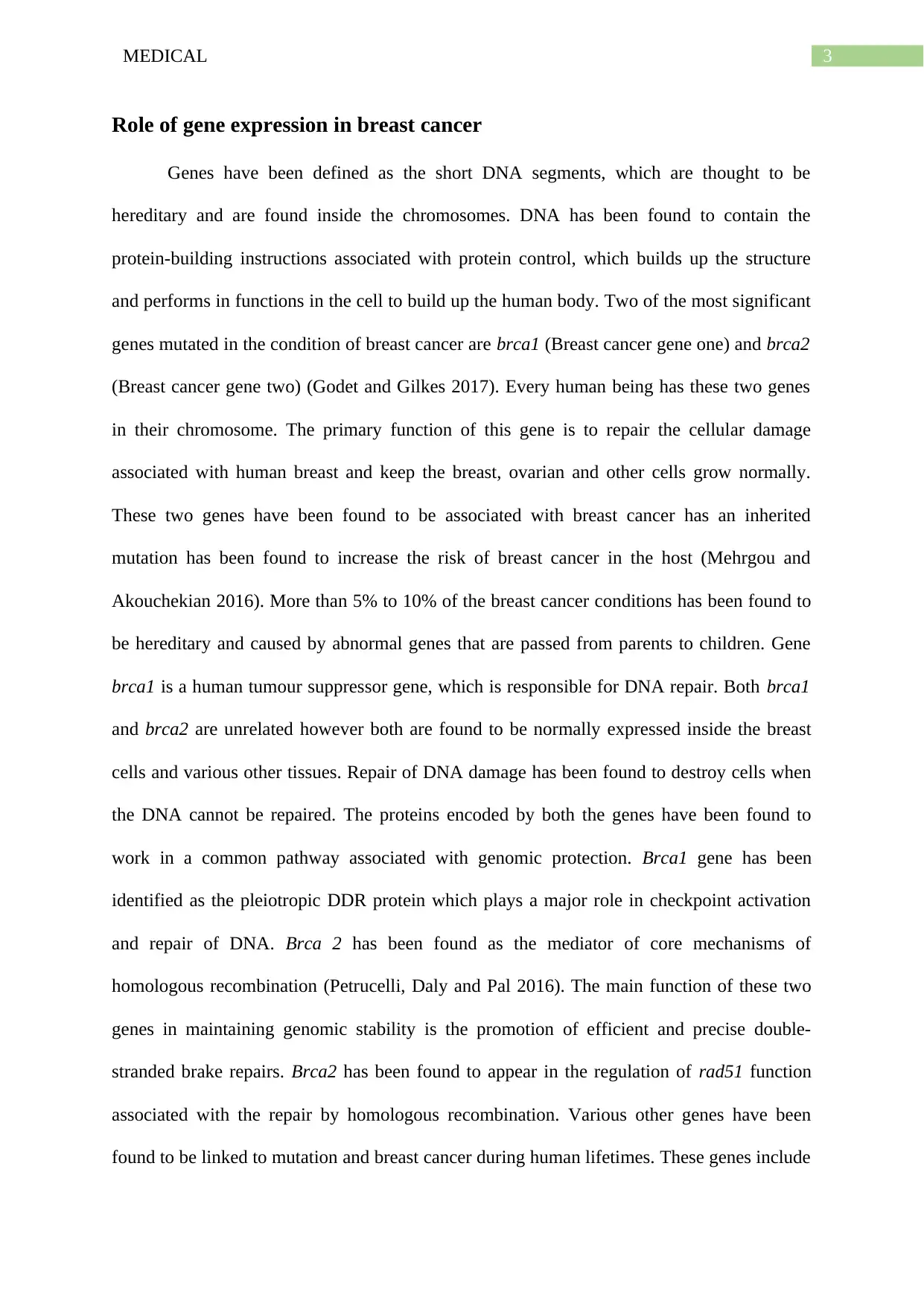
3MEDICAL
Role of gene expression in breast cancer
Genes have been defined as the short DNA segments, which are thought to be
hereditary and are found inside the chromosomes. DNA has been found to contain the
protein-building instructions associated with protein control, which builds up the structure
and performs in functions in the cell to build up the human body. Two of the most significant
genes mutated in the condition of breast cancer are brca1 (Breast cancer gene one) and brca2
(Breast cancer gene two) (Godet and Gilkes 2017). Every human being has these two genes
in their chromosome. The primary function of this gene is to repair the cellular damage
associated with human breast and keep the breast, ovarian and other cells grow normally.
These two genes have been found to be associated with breast cancer has an inherited
mutation has been found to increase the risk of breast cancer in the host (Mehrgou and
Akouchekian 2016). More than 5% to 10% of the breast cancer conditions has been found to
be hereditary and caused by abnormal genes that are passed from parents to children. Gene
brca1 is a human tumour suppressor gene, which is responsible for DNA repair. Both brca1
and brca2 are unrelated however both are found to be normally expressed inside the breast
cells and various other tissues. Repair of DNA damage has been found to destroy cells when
the DNA cannot be repaired. The proteins encoded by both the genes have been found to
work in a common pathway associated with genomic protection. Brca1 gene has been
identified as the pleiotropic DDR protein which plays a major role in checkpoint activation
and repair of DNA. Brca 2 has been found as the mediator of core mechanisms of
homologous recombination (Petrucelli, Daly and Pal 2016). The main function of these two
genes in maintaining genomic stability is the promotion of efficient and precise double-
stranded brake repairs. Brca2 has been found to appear in the regulation of rad51 function
associated with the repair by homologous recombination. Various other genes have been
found to be linked to mutation and breast cancer during human lifetimes. These genes include
Role of gene expression in breast cancer
Genes have been defined as the short DNA segments, which are thought to be
hereditary and are found inside the chromosomes. DNA has been found to contain the
protein-building instructions associated with protein control, which builds up the structure
and performs in functions in the cell to build up the human body. Two of the most significant
genes mutated in the condition of breast cancer are brca1 (Breast cancer gene one) and brca2
(Breast cancer gene two) (Godet and Gilkes 2017). Every human being has these two genes
in their chromosome. The primary function of this gene is to repair the cellular damage
associated with human breast and keep the breast, ovarian and other cells grow normally.
These two genes have been found to be associated with breast cancer has an inherited
mutation has been found to increase the risk of breast cancer in the host (Mehrgou and
Akouchekian 2016). More than 5% to 10% of the breast cancer conditions has been found to
be hereditary and caused by abnormal genes that are passed from parents to children. Gene
brca1 is a human tumour suppressor gene, which is responsible for DNA repair. Both brca1
and brca2 are unrelated however both are found to be normally expressed inside the breast
cells and various other tissues. Repair of DNA damage has been found to destroy cells when
the DNA cannot be repaired. The proteins encoded by both the genes have been found to
work in a common pathway associated with genomic protection. Brca1 gene has been
identified as the pleiotropic DDR protein which plays a major role in checkpoint activation
and repair of DNA. Brca 2 has been found as the mediator of core mechanisms of
homologous recombination (Petrucelli, Daly and Pal 2016). The main function of these two
genes in maintaining genomic stability is the promotion of efficient and precise double-
stranded brake repairs. Brca2 has been found to appear in the regulation of rad51 function
associated with the repair by homologous recombination. Various other genes have been
found to be linked to mutation and breast cancer during human lifetimes. These genes include
Secure Best Marks with AI Grader
Need help grading? Try our AI Grader for instant feedback on your assignments.
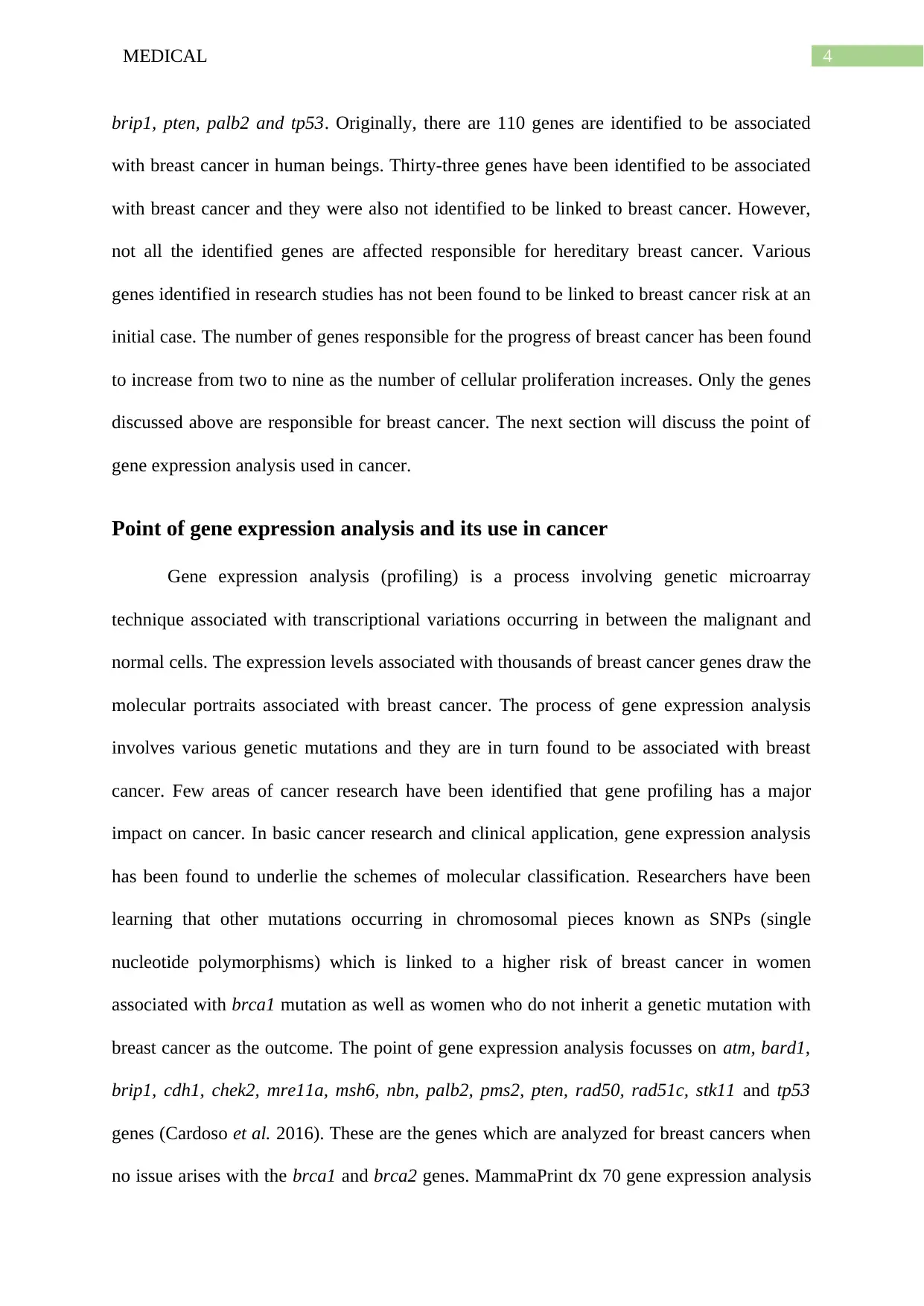
4MEDICAL
brip1, pten, palb2 and tp53. Originally, there are 110 genes are identified to be associated
with breast cancer in human beings. Thirty-three genes have been identified to be associated
with breast cancer and they were also not identified to be linked to breast cancer. However,
not all the identified genes are affected responsible for hereditary breast cancer. Various
genes identified in research studies has not been found to be linked to breast cancer risk at an
initial case. The number of genes responsible for the progress of breast cancer has been found
to increase from two to nine as the number of cellular proliferation increases. Only the genes
discussed above are responsible for breast cancer. The next section will discuss the point of
gene expression analysis used in cancer.
Point of gene expression analysis and its use in cancer
Gene expression analysis (profiling) is a process involving genetic microarray
technique associated with transcriptional variations occurring in between the malignant and
normal cells. The expression levels associated with thousands of breast cancer genes draw the
molecular portraits associated with breast cancer. The process of gene expression analysis
involves various genetic mutations and they are in turn found to be associated with breast
cancer. Few areas of cancer research have been identified that gene profiling has a major
impact on cancer. In basic cancer research and clinical application, gene expression analysis
has been found to underlie the schemes of molecular classification. Researchers have been
learning that other mutations occurring in chromosomal pieces known as SNPs (single
nucleotide polymorphisms) which is linked to a higher risk of breast cancer in women
associated with brca1 mutation as well as women who do not inherit a genetic mutation with
breast cancer as the outcome. The point of gene expression analysis focusses on atm, bard1,
brip1, cdh1, chek2, mre11a, msh6, nbn, palb2, pms2, pten, rad50, rad51c, stk11 and tp53
genes (Cardoso et al. 2016). These are the genes which are analyzed for breast cancers when
no issue arises with the brca1 and brca2 genes. MammaPrint dx 70 gene expression analysis
brip1, pten, palb2 and tp53. Originally, there are 110 genes are identified to be associated
with breast cancer in human beings. Thirty-three genes have been identified to be associated
with breast cancer and they were also not identified to be linked to breast cancer. However,
not all the identified genes are affected responsible for hereditary breast cancer. Various
genes identified in research studies has not been found to be linked to breast cancer risk at an
initial case. The number of genes responsible for the progress of breast cancer has been found
to increase from two to nine as the number of cellular proliferation increases. Only the genes
discussed above are responsible for breast cancer. The next section will discuss the point of
gene expression analysis used in cancer.
Point of gene expression analysis and its use in cancer
Gene expression analysis (profiling) is a process involving genetic microarray
technique associated with transcriptional variations occurring in between the malignant and
normal cells. The expression levels associated with thousands of breast cancer genes draw the
molecular portraits associated with breast cancer. The process of gene expression analysis
involves various genetic mutations and they are in turn found to be associated with breast
cancer. Few areas of cancer research have been identified that gene profiling has a major
impact on cancer. In basic cancer research and clinical application, gene expression analysis
has been found to underlie the schemes of molecular classification. Researchers have been
learning that other mutations occurring in chromosomal pieces known as SNPs (single
nucleotide polymorphisms) which is linked to a higher risk of breast cancer in women
associated with brca1 mutation as well as women who do not inherit a genetic mutation with
breast cancer as the outcome. The point of gene expression analysis focusses on atm, bard1,
brip1, cdh1, chek2, mre11a, msh6, nbn, palb2, pms2, pten, rad50, rad51c, stk11 and tp53
genes (Cardoso et al. 2016). These are the genes which are analyzed for breast cancers when
no issue arises with the brca1 and brca2 genes. MammaPrint dx 70 gene expression analysis
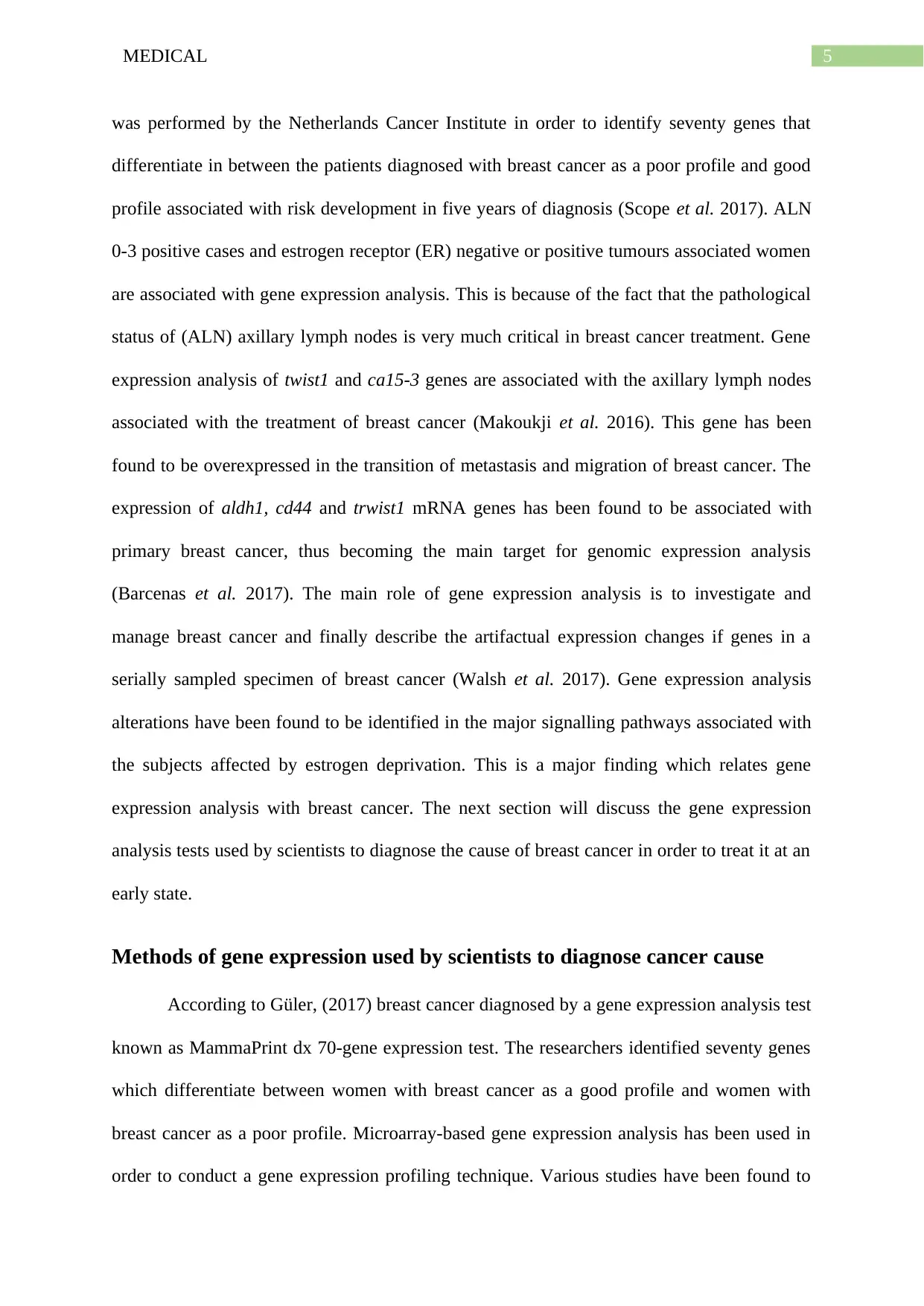
5MEDICAL
was performed by the Netherlands Cancer Institute in order to identify seventy genes that
differentiate in between the patients diagnosed with breast cancer as a poor profile and good
profile associated with risk development in five years of diagnosis (Scope et al. 2017). ALN
0-3 positive cases and estrogen receptor (ER) negative or positive tumours associated women
are associated with gene expression analysis. This is because of the fact that the pathological
status of (ALN) axillary lymph nodes is very much critical in breast cancer treatment. Gene
expression analysis of twist1 and ca15-3 genes are associated with the axillary lymph nodes
associated with the treatment of breast cancer (Makoukji et al. 2016). This gene has been
found to be overexpressed in the transition of metastasis and migration of breast cancer. The
expression of aldh1, cd44 and trwist1 mRNA genes has been found to be associated with
primary breast cancer, thus becoming the main target for genomic expression analysis
(Barcenas et al. 2017). The main role of gene expression analysis is to investigate and
manage breast cancer and finally describe the artifactual expression changes if genes in a
serially sampled specimen of breast cancer (Walsh et al. 2017). Gene expression analysis
alterations have been found to be identified in the major signalling pathways associated with
the subjects affected by estrogen deprivation. This is a major finding which relates gene
expression analysis with breast cancer. The next section will discuss the gene expression
analysis tests used by scientists to diagnose the cause of breast cancer in order to treat it at an
early state.
Methods of gene expression used by scientists to diagnose cancer cause
According to Güler, (2017) breast cancer diagnosed by a gene expression analysis test
known as MammaPrint dx 70-gene expression test. The researchers identified seventy genes
which differentiate between women with breast cancer as a good profile and women with
breast cancer as a poor profile. Microarray-based gene expression analysis has been used in
order to conduct a gene expression profiling technique. Various studies have been found to
was performed by the Netherlands Cancer Institute in order to identify seventy genes that
differentiate in between the patients diagnosed with breast cancer as a poor profile and good
profile associated with risk development in five years of diagnosis (Scope et al. 2017). ALN
0-3 positive cases and estrogen receptor (ER) negative or positive tumours associated women
are associated with gene expression analysis. This is because of the fact that the pathological
status of (ALN) axillary lymph nodes is very much critical in breast cancer treatment. Gene
expression analysis of twist1 and ca15-3 genes are associated with the axillary lymph nodes
associated with the treatment of breast cancer (Makoukji et al. 2016). This gene has been
found to be overexpressed in the transition of metastasis and migration of breast cancer. The
expression of aldh1, cd44 and trwist1 mRNA genes has been found to be associated with
primary breast cancer, thus becoming the main target for genomic expression analysis
(Barcenas et al. 2017). The main role of gene expression analysis is to investigate and
manage breast cancer and finally describe the artifactual expression changes if genes in a
serially sampled specimen of breast cancer (Walsh et al. 2017). Gene expression analysis
alterations have been found to be identified in the major signalling pathways associated with
the subjects affected by estrogen deprivation. This is a major finding which relates gene
expression analysis with breast cancer. The next section will discuss the gene expression
analysis tests used by scientists to diagnose the cause of breast cancer in order to treat it at an
early state.
Methods of gene expression used by scientists to diagnose cancer cause
According to Güler, (2017) breast cancer diagnosed by a gene expression analysis test
known as MammaPrint dx 70-gene expression test. The researchers identified seventy genes
which differentiate between women with breast cancer as a good profile and women with
breast cancer as a poor profile. Microarray-based gene expression analysis has been used in
order to conduct a gene expression profiling technique. Various studies have been found to
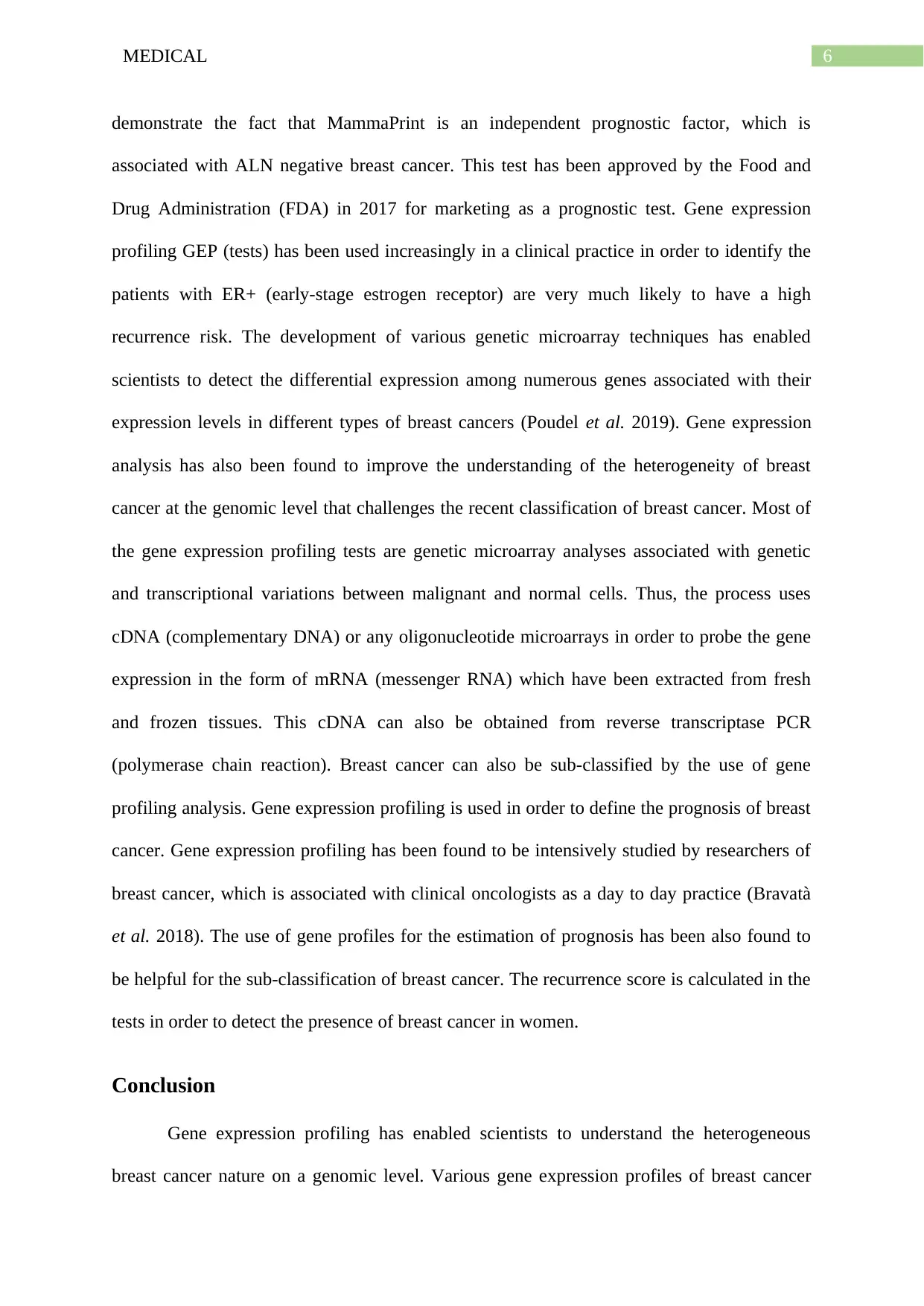
6MEDICAL
demonstrate the fact that MammaPrint is an independent prognostic factor, which is
associated with ALN negative breast cancer. This test has been approved by the Food and
Drug Administration (FDA) in 2017 for marketing as a prognostic test. Gene expression
profiling GEP (tests) has been used increasingly in a clinical practice in order to identify the
patients with ER+ (early-stage estrogen receptor) are very much likely to have a high
recurrence risk. The development of various genetic microarray techniques has enabled
scientists to detect the differential expression among numerous genes associated with their
expression levels in different types of breast cancers (Poudel et al. 2019). Gene expression
analysis has also been found to improve the understanding of the heterogeneity of breast
cancer at the genomic level that challenges the recent classification of breast cancer. Most of
the gene expression profiling tests are genetic microarray analyses associated with genetic
and transcriptional variations between malignant and normal cells. Thus, the process uses
cDNA (complementary DNA) or any oligonucleotide microarrays in order to probe the gene
expression in the form of mRNA (messenger RNA) which have been extracted from fresh
and frozen tissues. This cDNA can also be obtained from reverse transcriptase PCR
(polymerase chain reaction). Breast cancer can also be sub-classified by the use of gene
profiling analysis. Gene expression profiling is used in order to define the prognosis of breast
cancer. Gene expression profiling has been found to be intensively studied by researchers of
breast cancer, which is associated with clinical oncologists as a day to day practice (Bravatà
et al. 2018). The use of gene profiles for the estimation of prognosis has been also found to
be helpful for the sub-classification of breast cancer. The recurrence score is calculated in the
tests in order to detect the presence of breast cancer in women.
Conclusion
Gene expression profiling has enabled scientists to understand the heterogeneous
breast cancer nature on a genomic level. Various gene expression profiles of breast cancer
demonstrate the fact that MammaPrint is an independent prognostic factor, which is
associated with ALN negative breast cancer. This test has been approved by the Food and
Drug Administration (FDA) in 2017 for marketing as a prognostic test. Gene expression
profiling GEP (tests) has been used increasingly in a clinical practice in order to identify the
patients with ER+ (early-stage estrogen receptor) are very much likely to have a high
recurrence risk. The development of various genetic microarray techniques has enabled
scientists to detect the differential expression among numerous genes associated with their
expression levels in different types of breast cancers (Poudel et al. 2019). Gene expression
analysis has also been found to improve the understanding of the heterogeneity of breast
cancer at the genomic level that challenges the recent classification of breast cancer. Most of
the gene expression profiling tests are genetic microarray analyses associated with genetic
and transcriptional variations between malignant and normal cells. Thus, the process uses
cDNA (complementary DNA) or any oligonucleotide microarrays in order to probe the gene
expression in the form of mRNA (messenger RNA) which have been extracted from fresh
and frozen tissues. This cDNA can also be obtained from reverse transcriptase PCR
(polymerase chain reaction). Breast cancer can also be sub-classified by the use of gene
profiling analysis. Gene expression profiling is used in order to define the prognosis of breast
cancer. Gene expression profiling has been found to be intensively studied by researchers of
breast cancer, which is associated with clinical oncologists as a day to day practice (Bravatà
et al. 2018). The use of gene profiles for the estimation of prognosis has been also found to
be helpful for the sub-classification of breast cancer. The recurrence score is calculated in the
tests in order to detect the presence of breast cancer in women.
Conclusion
Gene expression profiling has enabled scientists to understand the heterogeneous
breast cancer nature on a genomic level. Various gene expression profiles of breast cancer
Paraphrase This Document
Need a fresh take? Get an instant paraphrase of this document with our AI Paraphraser
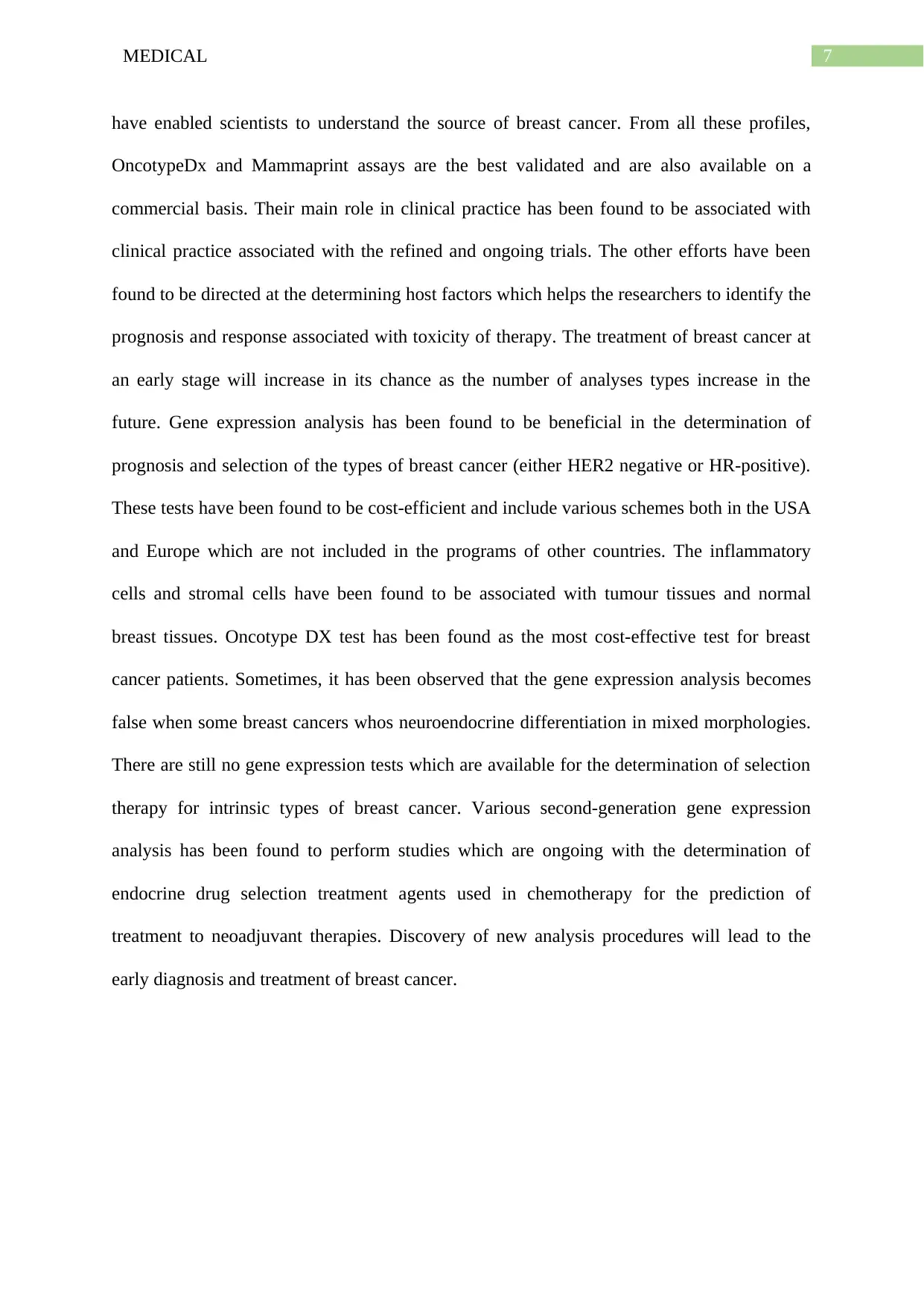
7MEDICAL
have enabled scientists to understand the source of breast cancer. From all these profiles,
OncotypeDx and Mammaprint assays are the best validated and are also available on a
commercial basis. Their main role in clinical practice has been found to be associated with
clinical practice associated with the refined and ongoing trials. The other efforts have been
found to be directed at the determining host factors which helps the researchers to identify the
prognosis and response associated with toxicity of therapy. The treatment of breast cancer at
an early stage will increase in its chance as the number of analyses types increase in the
future. Gene expression analysis has been found to be beneficial in the determination of
prognosis and selection of the types of breast cancer (either HER2 negative or HR-positive).
These tests have been found to be cost-efficient and include various schemes both in the USA
and Europe which are not included in the programs of other countries. The inflammatory
cells and stromal cells have been found to be associated with tumour tissues and normal
breast tissues. Oncotype DX test has been found as the most cost-effective test for breast
cancer patients. Sometimes, it has been observed that the gene expression analysis becomes
false when some breast cancers whos neuroendocrine differentiation in mixed morphologies.
There are still no gene expression tests which are available for the determination of selection
therapy for intrinsic types of breast cancer. Various second-generation gene expression
analysis has been found to perform studies which are ongoing with the determination of
endocrine drug selection treatment agents used in chemotherapy for the prediction of
treatment to neoadjuvant therapies. Discovery of new analysis procedures will lead to the
early diagnosis and treatment of breast cancer.
have enabled scientists to understand the source of breast cancer. From all these profiles,
OncotypeDx and Mammaprint assays are the best validated and are also available on a
commercial basis. Their main role in clinical practice has been found to be associated with
clinical practice associated with the refined and ongoing trials. The other efforts have been
found to be directed at the determining host factors which helps the researchers to identify the
prognosis and response associated with toxicity of therapy. The treatment of breast cancer at
an early stage will increase in its chance as the number of analyses types increase in the
future. Gene expression analysis has been found to be beneficial in the determination of
prognosis and selection of the types of breast cancer (either HER2 negative or HR-positive).
These tests have been found to be cost-efficient and include various schemes both in the USA
and Europe which are not included in the programs of other countries. The inflammatory
cells and stromal cells have been found to be associated with tumour tissues and normal
breast tissues. Oncotype DX test has been found as the most cost-effective test for breast
cancer patients. Sometimes, it has been observed that the gene expression analysis becomes
false when some breast cancers whos neuroendocrine differentiation in mixed morphologies.
There are still no gene expression tests which are available for the determination of selection
therapy for intrinsic types of breast cancer. Various second-generation gene expression
analysis has been found to perform studies which are ongoing with the determination of
endocrine drug selection treatment agents used in chemotherapy for the prediction of
treatment to neoadjuvant therapies. Discovery of new analysis procedures will lead to the
early diagnosis and treatment of breast cancer.
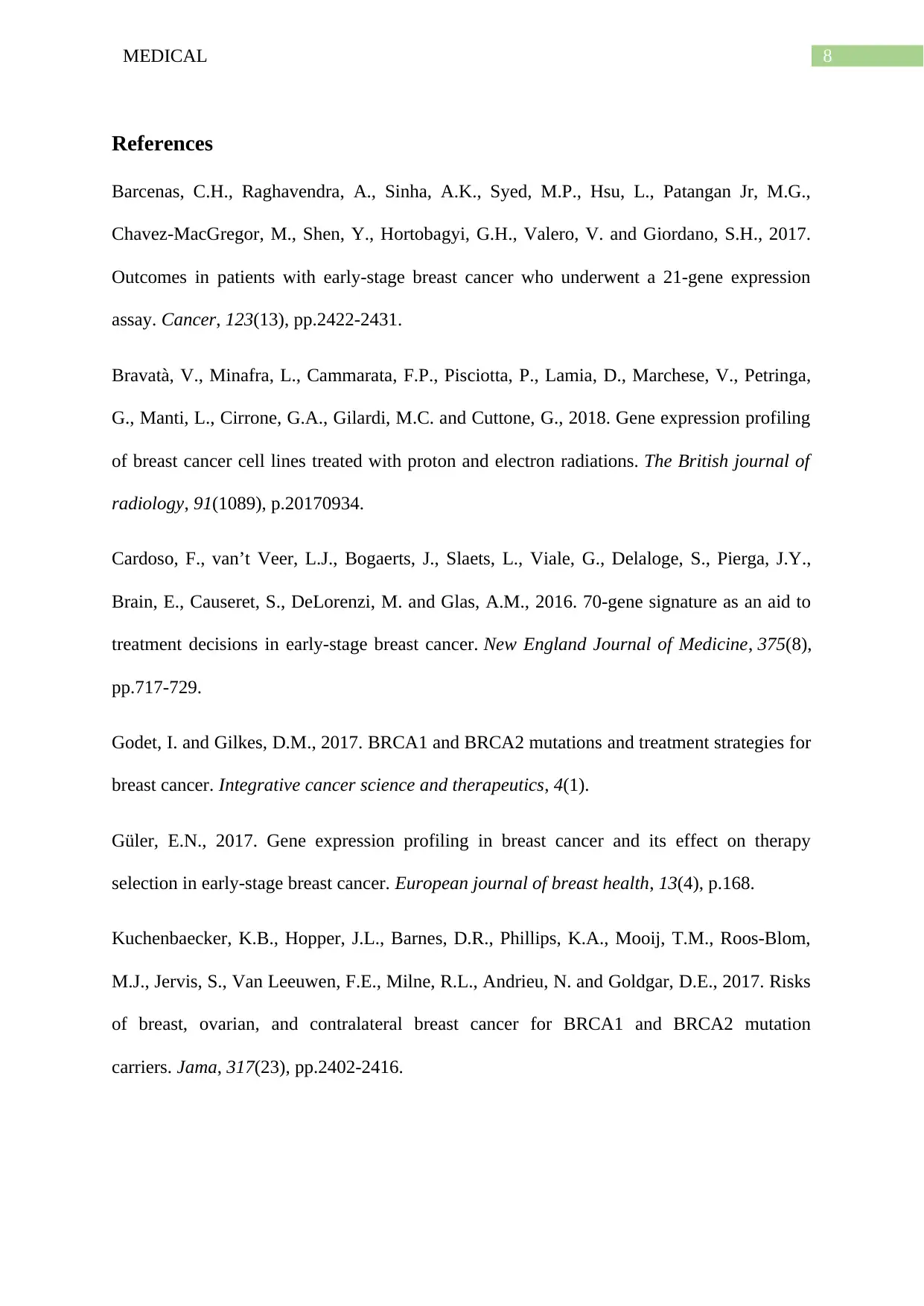
8MEDICAL
References
Barcenas, C.H., Raghavendra, A., Sinha, A.K., Syed, M.P., Hsu, L., Patangan Jr, M.G.,
Chavez‐MacGregor, M., Shen, Y., Hortobagyi, G.H., Valero, V. and Giordano, S.H., 2017.
Outcomes in patients with early‐stage breast cancer who underwent a 21‐gene expression
assay. Cancer, 123(13), pp.2422-2431.
Bravatà, V., Minafra, L., Cammarata, F.P., Pisciotta, P., Lamia, D., Marchese, V., Petringa,
G., Manti, L., Cirrone, G.A., Gilardi, M.C. and Cuttone, G., 2018. Gene expression profiling
of breast cancer cell lines treated with proton and electron radiations. The British journal of
radiology, 91(1089), p.20170934.
Cardoso, F., van’t Veer, L.J., Bogaerts, J., Slaets, L., Viale, G., Delaloge, S., Pierga, J.Y.,
Brain, E., Causeret, S., DeLorenzi, M. and Glas, A.M., 2016. 70-gene signature as an aid to
treatment decisions in early-stage breast cancer. New England Journal of Medicine, 375(8),
pp.717-729.
Godet, I. and Gilkes, D.M., 2017. BRCA1 and BRCA2 mutations and treatment strategies for
breast cancer. Integrative cancer science and therapeutics, 4(1).
Güler, E.N., 2017. Gene expression profiling in breast cancer and its effect on therapy
selection in early-stage breast cancer. European journal of breast health, 13(4), p.168.
Kuchenbaecker, K.B., Hopper, J.L., Barnes, D.R., Phillips, K.A., Mooij, T.M., Roos-Blom,
M.J., Jervis, S., Van Leeuwen, F.E., Milne, R.L., Andrieu, N. and Goldgar, D.E., 2017. Risks
of breast, ovarian, and contralateral breast cancer for BRCA1 and BRCA2 mutation
carriers. Jama, 317(23), pp.2402-2416.
References
Barcenas, C.H., Raghavendra, A., Sinha, A.K., Syed, M.P., Hsu, L., Patangan Jr, M.G.,
Chavez‐MacGregor, M., Shen, Y., Hortobagyi, G.H., Valero, V. and Giordano, S.H., 2017.
Outcomes in patients with early‐stage breast cancer who underwent a 21‐gene expression
assay. Cancer, 123(13), pp.2422-2431.
Bravatà, V., Minafra, L., Cammarata, F.P., Pisciotta, P., Lamia, D., Marchese, V., Petringa,
G., Manti, L., Cirrone, G.A., Gilardi, M.C. and Cuttone, G., 2018. Gene expression profiling
of breast cancer cell lines treated with proton and electron radiations. The British journal of
radiology, 91(1089), p.20170934.
Cardoso, F., van’t Veer, L.J., Bogaerts, J., Slaets, L., Viale, G., Delaloge, S., Pierga, J.Y.,
Brain, E., Causeret, S., DeLorenzi, M. and Glas, A.M., 2016. 70-gene signature as an aid to
treatment decisions in early-stage breast cancer. New England Journal of Medicine, 375(8),
pp.717-729.
Godet, I. and Gilkes, D.M., 2017. BRCA1 and BRCA2 mutations and treatment strategies for
breast cancer. Integrative cancer science and therapeutics, 4(1).
Güler, E.N., 2017. Gene expression profiling in breast cancer and its effect on therapy
selection in early-stage breast cancer. European journal of breast health, 13(4), p.168.
Kuchenbaecker, K.B., Hopper, J.L., Barnes, D.R., Phillips, K.A., Mooij, T.M., Roos-Blom,
M.J., Jervis, S., Van Leeuwen, F.E., Milne, R.L., Andrieu, N. and Goldgar, D.E., 2017. Risks
of breast, ovarian, and contralateral breast cancer for BRCA1 and BRCA2 mutation
carriers. Jama, 317(23), pp.2402-2416.
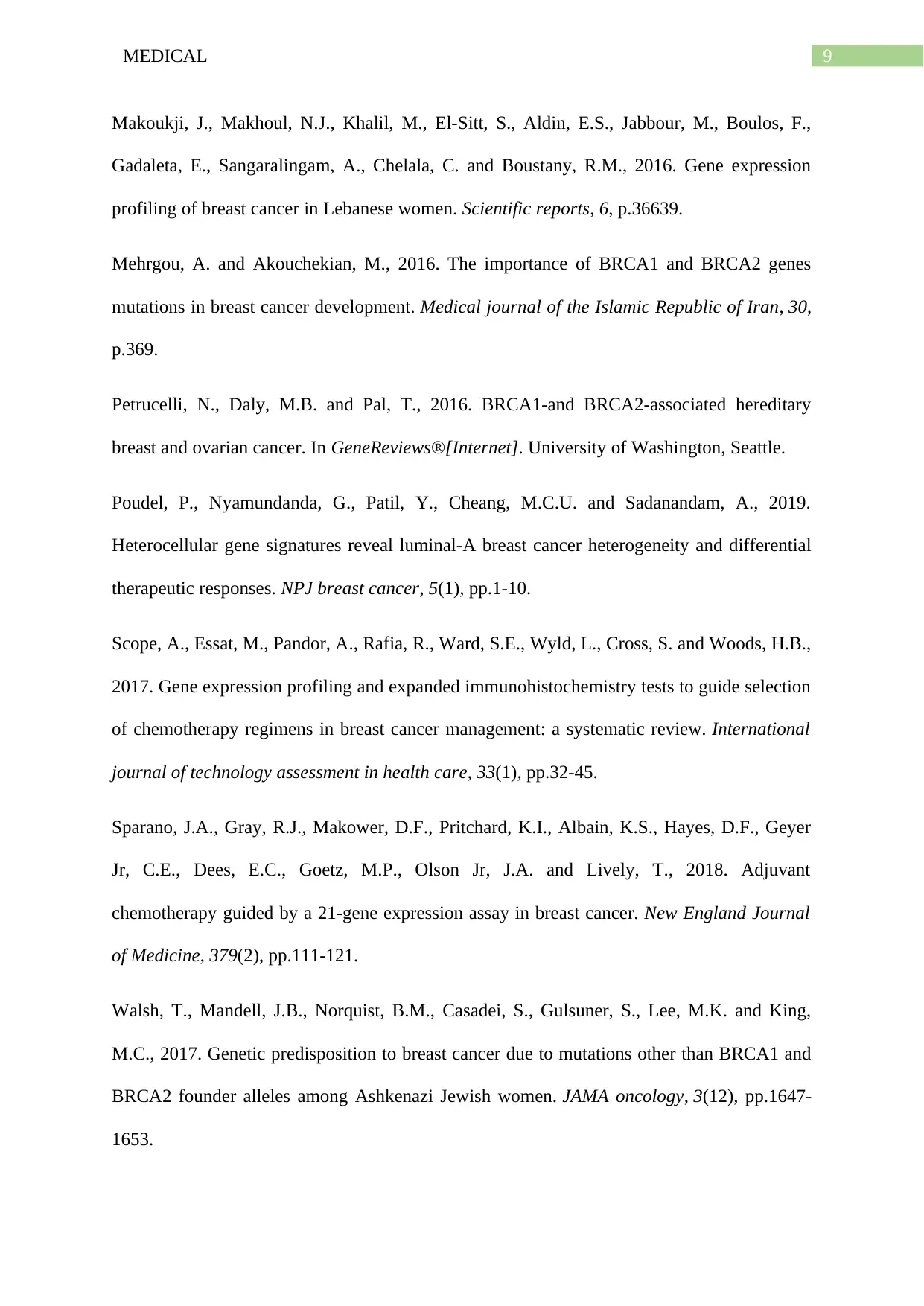
9MEDICAL
Makoukji, J., Makhoul, N.J., Khalil, M., El-Sitt, S., Aldin, E.S., Jabbour, M., Boulos, F.,
Gadaleta, E., Sangaralingam, A., Chelala, C. and Boustany, R.M., 2016. Gene expression
profiling of breast cancer in Lebanese women. Scientific reports, 6, p.36639.
Mehrgou, A. and Akouchekian, M., 2016. The importance of BRCA1 and BRCA2 genes
mutations in breast cancer development. Medical journal of the Islamic Republic of Iran, 30,
p.369.
Petrucelli, N., Daly, M.B. and Pal, T., 2016. BRCA1-and BRCA2-associated hereditary
breast and ovarian cancer. In GeneReviews®[Internet]. University of Washington, Seattle.
Poudel, P., Nyamundanda, G., Patil, Y., Cheang, M.C.U. and Sadanandam, A., 2019.
Heterocellular gene signatures reveal luminal-A breast cancer heterogeneity and differential
therapeutic responses. NPJ breast cancer, 5(1), pp.1-10.
Scope, A., Essat, M., Pandor, A., Rafia, R., Ward, S.E., Wyld, L., Cross, S. and Woods, H.B.,
2017. Gene expression profiling and expanded immunohistochemistry tests to guide selection
of chemotherapy regimens in breast cancer management: a systematic review. International
journal of technology assessment in health care, 33(1), pp.32-45.
Sparano, J.A., Gray, R.J., Makower, D.F., Pritchard, K.I., Albain, K.S., Hayes, D.F., Geyer
Jr, C.E., Dees, E.C., Goetz, M.P., Olson Jr, J.A. and Lively, T., 2018. Adjuvant
chemotherapy guided by a 21-gene expression assay in breast cancer. New England Journal
of Medicine, 379(2), pp.111-121.
Walsh, T., Mandell, J.B., Norquist, B.M., Casadei, S., Gulsuner, S., Lee, M.K. and King,
M.C., 2017. Genetic predisposition to breast cancer due to mutations other than BRCA1 and
BRCA2 founder alleles among Ashkenazi Jewish women. JAMA oncology, 3(12), pp.1647-
1653.
Makoukji, J., Makhoul, N.J., Khalil, M., El-Sitt, S., Aldin, E.S., Jabbour, M., Boulos, F.,
Gadaleta, E., Sangaralingam, A., Chelala, C. and Boustany, R.M., 2016. Gene expression
profiling of breast cancer in Lebanese women. Scientific reports, 6, p.36639.
Mehrgou, A. and Akouchekian, M., 2016. The importance of BRCA1 and BRCA2 genes
mutations in breast cancer development. Medical journal of the Islamic Republic of Iran, 30,
p.369.
Petrucelli, N., Daly, M.B. and Pal, T., 2016. BRCA1-and BRCA2-associated hereditary
breast and ovarian cancer. In GeneReviews®[Internet]. University of Washington, Seattle.
Poudel, P., Nyamundanda, G., Patil, Y., Cheang, M.C.U. and Sadanandam, A., 2019.
Heterocellular gene signatures reveal luminal-A breast cancer heterogeneity and differential
therapeutic responses. NPJ breast cancer, 5(1), pp.1-10.
Scope, A., Essat, M., Pandor, A., Rafia, R., Ward, S.E., Wyld, L., Cross, S. and Woods, H.B.,
2017. Gene expression profiling and expanded immunohistochemistry tests to guide selection
of chemotherapy regimens in breast cancer management: a systematic review. International
journal of technology assessment in health care, 33(1), pp.32-45.
Sparano, J.A., Gray, R.J., Makower, D.F., Pritchard, K.I., Albain, K.S., Hayes, D.F., Geyer
Jr, C.E., Dees, E.C., Goetz, M.P., Olson Jr, J.A. and Lively, T., 2018. Adjuvant
chemotherapy guided by a 21-gene expression assay in breast cancer. New England Journal
of Medicine, 379(2), pp.111-121.
Walsh, T., Mandell, J.B., Norquist, B.M., Casadei, S., Gulsuner, S., Lee, M.K. and King,
M.C., 2017. Genetic predisposition to breast cancer due to mutations other than BRCA1 and
BRCA2 founder alleles among Ashkenazi Jewish women. JAMA oncology, 3(12), pp.1647-
1653.
1 out of 10
Related Documents
Your All-in-One AI-Powered Toolkit for Academic Success.
+13062052269
info@desklib.com
Available 24*7 on WhatsApp / Email
![[object Object]](/_next/static/media/star-bottom.7253800d.svg)
Unlock your academic potential
© 2024 | Zucol Services PVT LTD | All rights reserved.





